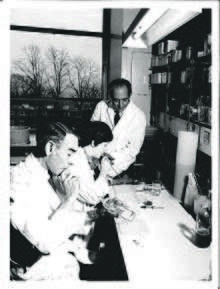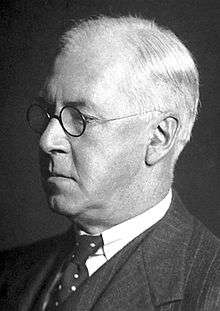National Institute for Medical Research
The National Institute for Medical Research (commonly abbreviated to NIMR), was a medical research institute based in Mill Hill, on the outskirts of north London, England. It was funded by the Medical Research Council (MRC);
 | |
The main building of the National Institute for Medical Research | |
| Abbreviation | NIMR |
|---|---|
| Formation | 1913 |
| Legal status | Government agency |
| Purpose | Biological research |
| Location |
|
Region served | United Kingdom |
Membership | 240 scientists |
Director | Prof Jim Smith |
Parent organization | Medical Research Council (MRC) |
| Affiliations | BBSRC, WHO, NHS, Dstl |
| Website | www.nimr.mrc.ac.uk |
In 2016, the NIMR became part of the new Francis Crick Institute, which was constructed next to St Pancras railway station in the Camden area of central London.
History
Foundation
The Medical Research Council, founded in 1913, was immediately charged with establishing a central research institute in London. Later that year, premises at Hampstead were acquired and the National Institute for Medical Research was founded.
However, the outbreak of World War I soon afterwards postponed occupation of the building, although senior staff were appointed and began work. By 1920 the Institute at Mount Vernon Hospital was fully operational and remained so for 30 years until the move to its current location at Mill Hill. The original Institute, under the directorship of Sir Henry Dale, had three divisions:
- Bacteriology
- Biochemistry and Pharmacology
- Applied Physiology
Dale oversaw a period of considerable success at NIMR, including the discovery of the human influenza virus in 1933 and the discovery of the neurotransmitter acetylcholine, for which Dale himself received the 1936 Nobel Prize in Physiology or Medicine.
Moving to Mill Hill

In the 1930s, the decision was made to move the Institute to new premises. An imposing copper-roofed building at Mill Hill was designed by Maxwell Ayrton, the architect of the original Wembley Stadium, and construction began in 1937. Occupation was delayed when war broke out in 1939 and the building was given to the Women's Royal Naval Service. The building was returned to the MRC in autumn 1949 but Dale had retired in 1942 and so was never director on the new site, that job falling to his successor Sir Charles Harington.

The official opening ceremony took place on 5 May 1950, with King George VI and Queen Elizabeth present. Harington expanded the research programme into ten divisions during his 20-year tenure and guided researchers at the Institute to, amongst other achievements, the development of gas chromatography and the discovery of interferon. From 1950-55 Albert Neuberger was Head of Biochemistry at the Institute.
In 1962, Nobel Prize winner Sir Peter Medawar became director and, consistent with his research interests, established NIMR as a major centre for immunological research. Following an illness, Medawar retired as director in 1971 to be replaced by Sir Arnold Burgen. Burgen had an interest in nuclear magnetic resonance techniques and formed the MRC Biomedical NMR Centre at the Institute in 1980. Sir Dai Rees became director in 1982 to be replaced by Sir John Skehel in 1987. Since then NIMR has continued to excel scientifically, reporting perhaps most famously the discovery of the sex determining gene SRY, in 1991.
2000 to present

In 2003, as part of their Forward Investment Strategy, the MRC announced plans to consider moving NIMR from its current location to a university/medical school site, to enhance its ability "to translate its biomedical research into practical health outcomes." [1][2] University College London was selected as a preferred partner institution, and a nearby site in central London was acquired.[3]
Some staff at the NIMR, including Robin Lovell-Badge and Skehel, expressed opposition to a move. In response to accusations of "coercion" during the review process, a House of Commons select committee investigation criticised both the MRC for losing the confidence of NIMR workers, and unnamed NIMR staff for "undermining [Colin] Blakemore's position as MRC chief executive." [4][5]
In September 2006, Skehel retired as NIMR director [6] and Sir Keith Peters became acting director [7] until the future structure of the new institute could be finalised. In July of that year the MRC announced that Scott Fraser of the California Institute of Technology had been invited to take over the directorship.[8] According to Blakemore, negotiations were ongoing as of December 2006.[2] However, finally, in October 2008, Jim Smith of the Gurdon Institute, University of Cambridge (who worked at the NIMR from 1984 to 2000), accepted the directorship, with effect from January 2009.
On 1 April 2015, the NIMR became part of the new Francis Crick Institute[9] and ceased to exist as a separate MRC institute. The site at Mill Hill was fully vacated and closed for redevelopment during 2017.
In 2018 they started to demolish the building to make way for new homes.[10]
Activities
Mill Hill Essays
A yearly collection of essays is produced by guest authors and staff at the Institute, under the title Mill Hill Essays.[11] They are written to be accessible and informative to the lay reader.
Notable staff
- Gordon Ada AO FAA (1922–2012), Australian biochemist
- Rudolf K. Allemann, Swiss biological chemist
- Brigitte Askonas FMedSci FRS, (1923-2013), immunologist
- Brigid Balfour (1914–1994), immunologist
- Frank Hawking OX (1940-1970) parasitologist
- Rosa Beddington FRS (1956–2001), developmental biologist
- Hilda Bruce (1903–1974), zoologist, discoverer of the Bruce effect
- Sir Frank Macfarlane Burnet OM AK KBE FRSNZ (1899–1985), Australian virologist and immunologist, 1960 Nobel Prize for predicting acquired immune tolerance
- G. Marius Clore FRS (born 1955) – Pioneer of multidimensional macromolecular NMR spectroscopy laying foundations of 3D structure determination of proteins in solution, and discovery of rare, invisible conformational states of macromolecules. Member of the United States National Academy of Sciences.
- Sir Henry Hallett Dale OM GBE PRS, pharmacologist and physiologist and 1936 Nobel Prize in Physiology or Medicine
- Guy Dodson FRS FMedSci (1937–2012), biochemist
- Florence Margaret Durham (1869–1948), geneticist
- Sir David Evans FRS (1909-1984), microbiologist
- Wilhelm Feldberg CBE FRS (1900–1993), German-British physiologist and biologist
- Sir Charles Robert Harington FRS (1897-1972), chemist, best known for synthesizing thyroxine
- Sir Charles Arthur Lovatt Evans FRS (1884–1968), physiologist
- Cecil Hoare FRS (1892–1984), British protozoologist and parasitologist
- Brigid Hogan FRS, developmental biologist
- Alick Isaacs FRS (1921–1967), virologist, best known for his co-discovery of interferon at the National Institute in 1957
- Charles Kellaway MC FRS (1889–1952), Australian medical researcher and science administrator
- Jean Lindenmann (1924–2015), Swiss virologist, co-discovered interferon in 1957 with Dr. Alick Isaacs at the National Institute for Medical Research[12]
- Mary C. Lobban (1922–1982), physiologist who studied circadian rhythms
- Robin Lovell-Badge FRS, geneticist most noted for his discovery of the SRY gene in mammals
- Archer John Porter Martin FRS (1910–2002), chemist, 1952 Nobel Prize in Chemistry for the invention of partition chromatography
- Dame Anne McLaren DBE FRS FRCOG (1927-2007), developmental biologist
- Sir Peter Medawar OM CBE FRS (1915-1987), biologist, 1960 Nobel Prize in Physiology or Medicine with Sir Frank Macfarlane Burnet
- Marjorie Mussett (1922-2004), biologist and endocrinologist
- Indira Nath (born 1938), Indian immunologist
- Albert Neuberger CBE FRS FRCP (1908–1996) pathologist
- Janet Niven (1902–1974), histologist and pathologist
- Anne O'Garra FRS, immunologist
- Dame Bridget Ogilvie AC DBE FRS (born 1938), Australian and British scientist
- Delphine Parrott (born 1928), endocrinologist and immunologist
- Rosalind Pitt-Rivers FRS (1907–1990), biochemist
- Christopher Polge CBE FRS (1926–2006), biologist, most noted for his work in cryopreservation
- Rodney Robert Porter FRS (1917–1985), biochemist and Nobel Laureate
- Elizabeth Press (1920–2008), immunologist
- Sir John Skehel FRS (born 1941) virologist
- Audrey Smith (1915-1981), cryobiologist
- Geoffrey L. Smith FRS FMedSci (born 1955), virologist
- Jonathan P. Stoye, virologist
- Dame Janet Thornton DBE FRS (born 1949), Director of the European Bioinformatics Institute
- Saul Tendler Fellow of the Royal Pharmaceutical Society and Deputy Vice Chancellor of the University of York (born 1961)
- Anne Warner FRS, biologist
In fiction
The rooms and other locations in the building were used in the film Batman Begins, for the Arkham Asylum scenes.[13]
The location was also used in Episode 2, Series 2 of the Channel 4 comedy series, 'Toast of London' to double as a tax office with the character of Ray Purchase seen entering the building.
References
- "Archived copy". Medical Research Council. Archived from the original on 31 October 2006. Retrieved 21 December 2006.CS1 maint: archived copy as title (link)
- "Page cannot be found". Archived from the original on 2018-12-16. Retrieved 2019-10-11.
- Haverty, Amanda (19 November 2003). "Irish science funds flow again". The Scientist. Retrieved 3 July 2018.
- http://www.the-scientist.com/news/20050208/01/
- "House of Commons - Science and Technology - Fourth Report". parliament.uk.
- "Archived copy". Archived from the original on 2008-09-10. Retrieved 2006-12-22.CS1 maint: archived copy as title (link)
- "Archived copy". Archived from the original on 2008-09-10. Retrieved 2006-12-22.CS1 maint: archived copy as title (link)
- "404". 2014-05-30.
- "A new name for UKCMRI". crick.ac.uk. The Francis Crick Institute. 25 May 2011. Retrieved 3 November 2011.
- Jones, Nick (9 April 2018). "Demolition eats away at local landmark". The Barnet Society. Retrieved 3 July 2018.
- "Archived copy". Archived from the original on 2013-09-15. Retrieved 2013-09-05.CS1 maint: archived copy as title (link)
- Kolata, Gina (2015-01-22). "Jean Lindenmann, Who Made Interferon His Life's Work, Is Dead at 90". New York Times. Retrieved 2015-02-14.
- "From leafy suburbs to silver screen". Times Series.
